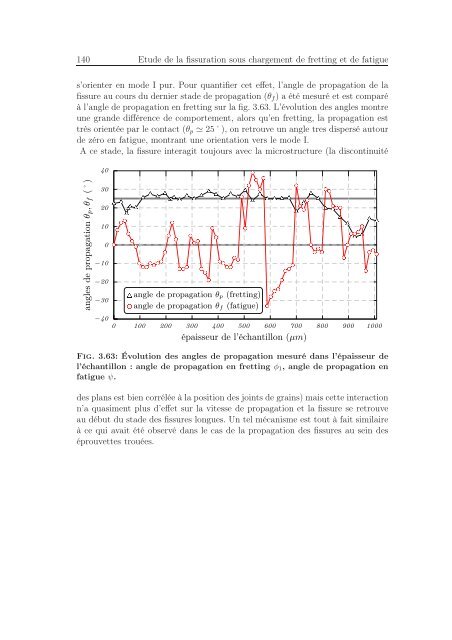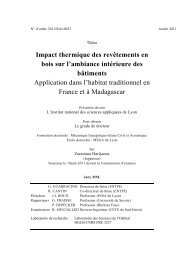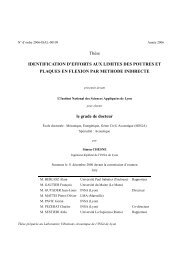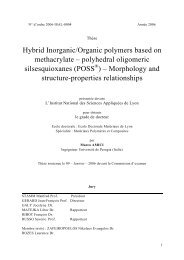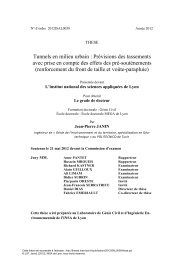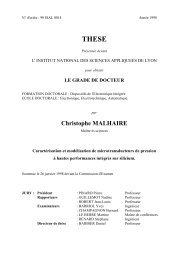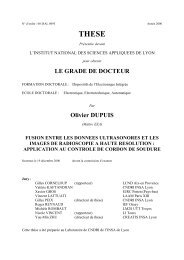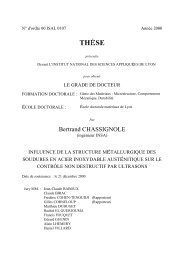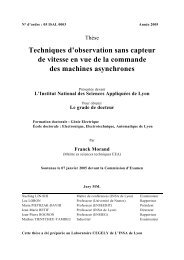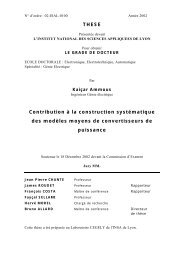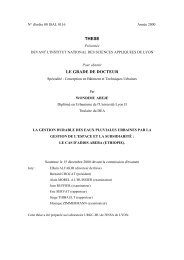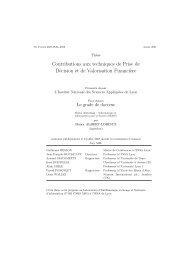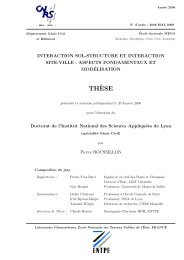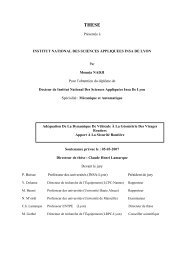Identification des mécanismes de fissuration dans un alliage d ...
Identification des mécanismes de fissuration dans un alliage d ...
Identification des mécanismes de fissuration dans un alliage d ...
Create successful ePaper yourself
Turn your PDF publications into a flip-book with our unique Google optimized e-Paper software.
140 Etu<strong>de</strong> <strong>de</strong> la <strong>fissuration</strong> sous chargement <strong>de</strong> fretting et <strong>de</strong> fatigue<br />
s’orienter en mo<strong>de</strong> I pur. Pour quantifier cet effet, l’angle <strong>de</strong> propagation <strong>de</strong> la<br />
fissure au cours du <strong>de</strong>rnier sta<strong>de</strong> <strong>de</strong> propagation (θ f ) a été mesuré et est comparé<br />
à l’angle <strong>de</strong> propagation en fretting sur la fig. 3.63. L’évolution <strong><strong>de</strong>s</strong> angles montre<br />
<strong>un</strong>e gran<strong>de</strong> différence <strong>de</strong> comportement, alors qu’en fretting, la propagation est<br />
très orientée par le contact (θ p ≃ 25˚), on retrouve <strong>un</strong> angle tres dispersé autour<br />
<strong>de</strong> zéro en fatigue, montrant <strong>un</strong>e orientation vers le mo<strong>de</strong> I.<br />
A ce sta<strong>de</strong>, la fissure interagit toujours avec la microstructure (la discontinuité<br />
angles <strong>de</strong> propagation θp, θf (˚)<br />
40<br />
30<br />
20<br />
10<br />
0<br />
−10<br />
−20<br />
−30<br />
−40<br />
•<br />
• •<br />
<br />
<br />
<br />
<br />
•<br />
<br />
<br />
<br />
•<br />
•<br />
••<br />
• <br />
•<br />
<br />
•<br />
•<br />
•••<br />
• • •<br />
•<br />
• •<br />
• •<br />
• •• •<br />
•<br />
• •<br />
•<br />
•<br />
•<br />
•<br />
• •<br />
• ••<br />
••••<br />
••<br />
••<br />
••• • •• •• •• •<br />
<br />
•<br />
angle <strong>de</strong> propagation θ p (fretting)<br />
angle <strong>de</strong> propagation θ f (fatigue)<br />
•<br />
• • •<br />
•<br />
<br />
<br />
<br />
<br />
••• • <br />
•<br />
•<br />
•<br />
0 100 200 300 400 500 600 700 800 900 1000<br />
épaisseur <strong>de</strong> l’échantillon (µm)<br />
<br />
•• •<br />
Fig. 3.63: Évolution <strong><strong>de</strong>s</strong> angles <strong>de</strong> propagation mesuré <strong>dans</strong> l’épaisseur <strong>de</strong><br />
l’échantillon : angle <strong>de</strong> propagation en fretting φ 1 , angle <strong>de</strong> propagation en<br />
fatigue ψ.<br />
<strong><strong>de</strong>s</strong> plans est bien corrélée à la position <strong><strong>de</strong>s</strong> joints <strong>de</strong> grains) mais cette interaction<br />
n’a quasiment plus d’effet sur la vitesse <strong>de</strong> propagation et la fissure se retrouve<br />
au début du sta<strong>de</strong> <strong><strong>de</strong>s</strong> fissures longues. Un tel mécanisme est tout à fait similaire<br />
à ce qui avait été observé <strong>dans</strong> le cas <strong>de</strong> la propagation <strong><strong>de</strong>s</strong> fissures au sein <strong><strong>de</strong>s</strong><br />
éprouvettes trouées.


